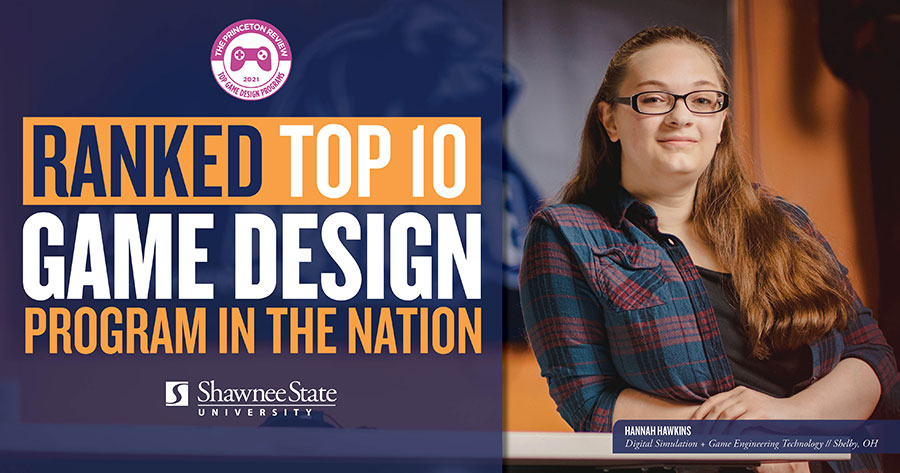June 22, 2021
Shawnee State University has been named for the 11th consecutive year to The Princeton Review’s Top Undergraduate Schools for Game Design. SSU placed in the top 10 for the second year in a row.

“At its core, our program is strong because of our professors, the care that we take with each student, and the accessibility we have here,” said Marcus Cenci, SSU Assistant Professor of Game Design noting that having only sixteen students per class allows the professors to take their classes into a deeper dive of their studies, while also having the opportunity to get to know their students more.
“The fact that all of the faculty are good at what they do and stay current and connected to the industry is what makes the program work so well against some very big competition and much larger programs,” he said, noting many of the current game instructors in the program have impressive prior experience in their fields, working for nationally and globally known studios and publishers.
The gaming industry has been evolving for many years, with Cenci having seen remarkable changes throughout his career, especially in game development and when consoles and platforms are upgraded.
“Ten years ago, I went from working on (football video game) Madden NFL with 12 artists to the Sony PlayStation 3 platform with 80 artists in just a year,” he said. “And today it’s even much bigger.”
As advancements continue to be made in the gaming industry, SSU’s programs help prepare students to specialize in new design elements. Many gaming studios now support entire teams of artists who work just on certain items, such as environments, weapons or clothing, among others. Cenci said developing a game today is very much like producing a blockbuster film, but sometimes with even greater pressure.
“When there is a console jump, the game has to be bigger, deeper and able to deliver so much more,” he said.
SSU’s four-year degrees offer two tracks focused on the different aspects of game design – one for game art: Gaming & Simulation Development Arts (Bachelor of Fine Arts) and one for game programming: Digital Simulation & Gaming Engineering Technology (Bachelor of Science).
“A lot of those larger programs don’t have both an art and a programming side,” said Duane Skaggs, SSU Associate Professor of Gaming Technology. “Or if they do, they are not as closely integrated. At SSU, art students do take programming courses and programming students take several art courses.”
Now in his 25th year of teaching and bringing extensive experience in theory as well as research in the field, Skaggs said the programming degree is a computer science degree but with a strong focus on gaming, creating games, and digital simulation.
“The students who come through our program are prepared for any kind of software development or software engineering,” he said. “In fact, a number of students who graduate from our program choose not to go directly to game companies.”
Skaggs said one of the important aspects of the program’s instruction is being able to communicate effectively.
“The students are experienced with being able to transition from programmer language to being able to communicate with other people about the programs,” he said, noting that the curriculum includes several required presentations and collaborative work.
As one of the top programs in the country SSU holds numerous events to engage current students with alumni and notable leaders in the field including the annual Shawnee Game Conference. The student culture also fosters teamwork and strong relationships. The gaming students belong to groups known as “houses” named after the faculty members and they engage in friendly competition throughout the year.
“We have competitions – house challenges,” Skaggs said. “These have included a variety of competitions, with awards, among the houses. These are groupings a student normally stays with from freshman to senior year. We also have homework nights, where you might find a freshman being helped by a senior or vice versa. Networking and connections are built and it’s really more than just a class cohort. It’s four years doing a lot together.”
The faculty in SSU’s program are optimistic about the career opportunities for their graduates.
“Most of our programming majors are working using their degree within six months of graduating,” Skaggs said. “This may not be in game studios, which can be very stressful when going from one project to another. The graduates do weigh the pay and security in non-studio jobs against those in gaming.”
“The future is very bright at SSU,” Cenci said. “We are talking about new tracks, new specializations. We are creating a hands-on experience with these experts and that really sets us apart.”
The Princeton Review chose the schools based on its 2021 survey of administrators at 150 institutions in the U.S., Canada, and abroad offering game design courses, majors, or degree programs. For more information about Shawnee State University’s gaming programs, visit shawnee.edu/gaming.
